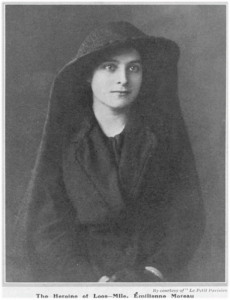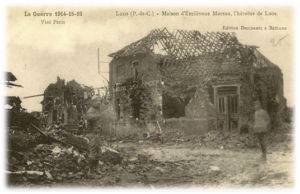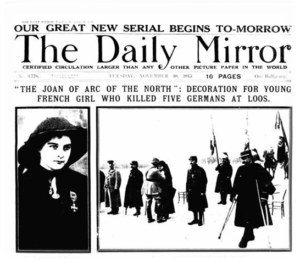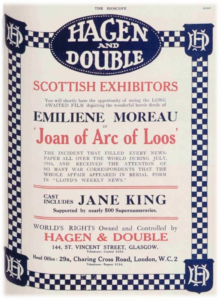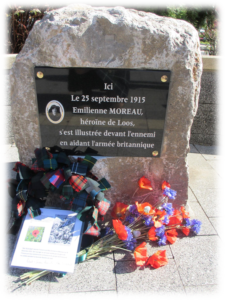Émilienne Moreau moved to Loos in June 1914, after her father had retired as a miner and become a manager of a small shop in the main square of Loos. Soon the Germans occupied the village and Émilienne was indignant about the actions of the invading forces. Though only 16 years old, she set up an observation post in the attic and watched through binoculars, observing the Germans digging shelters on the slag heaps and, on 8 October 1914, she saw a machine-gun post being set up. Seeing French soldiers on the hill, she set out to warn the French soldiers, running through a hail of gunfire to do so. Her bravery was recognised by a sergeant and she was told she was ‘a very brave girl’. When the town hall was in flames, she ran to put out the fire to save the public archives, ignoring German warnings and threats.
As this later postcard image illustrates that the home and shop of Émilienne’s parents and family was destroyed during the sieges of Loos-en-Gohelle but the family stayed on. During the Battle of Loos, Émilienne decided to give first aid to any injured British soldiers passing through the town. With her mother, she transformed the family home into a hospital and provided assistance to a British doctor who set up a clinic there. As the Battle of Loos rolled on, the streets were filled with many seriously wounded soldiers. Émilienne left the safety of her home to go on to the streets, under gunfire, to take drinks to those in need and separate the wounded from the dead.
When she saw three Germans head towards an injured Scottish soldier, she decided to attack them, accompanied by three other wounded soldiers, telling them, ‘I’ll go first’. Despite their attempted stealth, they were heard and subjected to more gunfire and bullets. She told the wounded soldiers to stop and showed them the doors to a cellar and, then amazingly, asked for two grenades.
The act which was to finally immortalise her actions occurred when Émilienne was with another soldier on a stretcher and was confronted by two German soldiers who pointed guns at them. Their shots missed but the now 17-year-old Émilienne’s did not: ‘The young girl spotted a revolver. Émilienne grabbed hold of it. Feverishly, she fired shot after shot at random and the Germans, shot at almost point-blank range, fell one after the other.’
Later, when on the way to Béthune as she took her sister for treatment for a shell injury, Émilienne was stopped and taken to the side and spoken to by a British senior officer, who wanted to thank her and tell her that he had advised both the French and British Governments of her actions.
Soon after, on 27 November 1915, following a mention in dispatches by General Ferdinand Foch, General de Sailly presented Émilienne Moreau with the Croix de Guerre with Palm. On the recommendation of General Douglas Haig, the British Ambassador in Paris also awarded her, in the name of King George V, the Military Medal, the Royal Red Cross First Class and the Medal of the Order of St John of Jerusalem.
Attr: Daily Mirror - Tuesday 30 November 1915 Image © Mirrorpix/Reach Licensing. Image created courtesy of THE BRITISH LIBRARY BOARD.
Émilienne was later to become the subject of a film, Joan of Arc of Loos, that was released in the UK in 1917
Attr: The Bioscope - Thursday 17 May 1917. Newspaper image © The British Library Board. All rights reserved. With thanks to The British Newspaper Archive (www.britishnewspaperarchive.co.uk).
This photograph shows my own personal tribute to Émilienne Moreau, which I laid at the memorial in the centre of Loos en Gohelle in October 2015. The wreath of many tartans symbolised all the Scottish soldiers that Émilienne looked out for and helped in 1915. The blue cornflowers and red poppies symbolise remembrance of all the French and British soldiers who served at Loos.
In late 2017, the Princess Royal, Princess Anne, named the main auditorium of the new French Institute and French Consulate General in Edinburgh, Salle Émilienne Moreau-Evrard. Émilienne had married Just Evrard in 1932. The Consulate General is in the former Lothian Chambers on The Royal Mile, opposite St Giles Cathedral, in the heart of Edinburgh. This tribute again underlined the strong association between Scotland and Émilienne.
